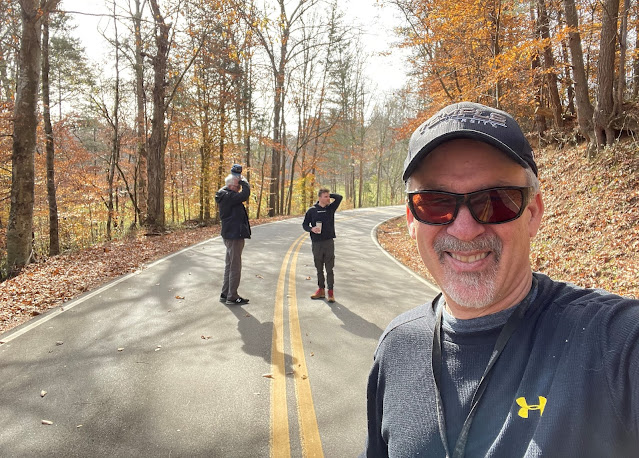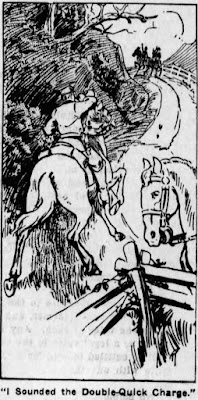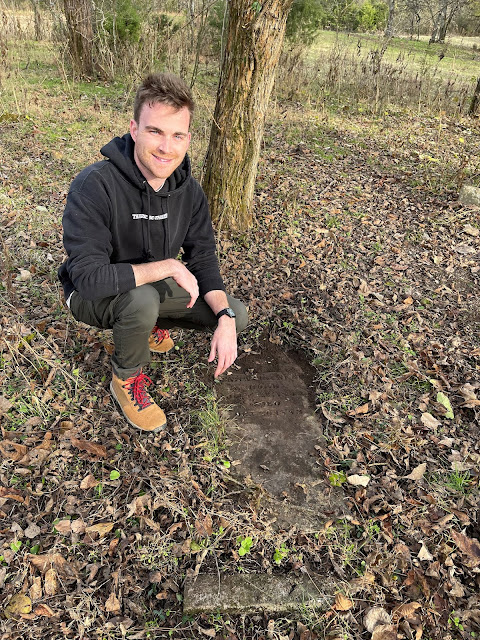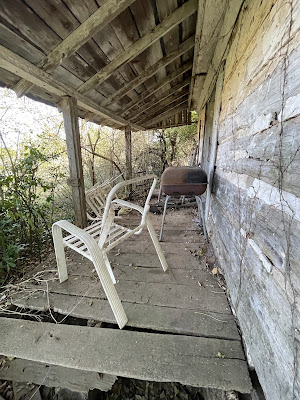 |
An illustration of Federal dead at Hollow Tree Gap published in The National Tribune,
a newspaper for veterans, on March 22, 1888. The figure in the foreground presumably
shows 16-year-old Duane A. Lewis. (CLICK ON IMAGES TO ENLARGE.) |
Like this blog on Facebook | My YouTube videos
Few who drive on heavily trafficked Franklin Road (U.S. Route 31) in metro Nashville today know anything about the historic pike's Civil War significance. On Dec. 16, 1864, in the aftermath of a disastrous defeat at the Battle of Nashville, beleaguered John Bell Hood's Army of Tennessee used the route to escape to Alabama.
The following day, in the vicinity of Franklin Road and present-day Moore's Lane, the U.S. Army lost 22 killed and 63 captured at Hollow (or Holly) Tree Gap in a fight against Hood's rearguard. On that raw and rainy day, 9th Indiana Cavalry officers spotted on the battlefield the body of one of their own, 16-year-old Duane A. Lewis—a "mere child" who was beloved by "every soldier in the brigade." A Confederate artillery round had killed the private, a shoemaker as a civilian and son of a widow.
Here's a snapshot of the life—and death—of Lewis, told via documents from his mother's pension file, a
regimental history, Google Street View, and other sources. I have traveled through the heart of this "lost" battlefield dozens of times. Now drives here will be more meaningful.
 |
| Duane A. Lewis in 1860 U.S. census | National Archives via fold3.com |
In 1860, Lewis lived with farmer William Keister and Elizabeth Keister—presumably relatives—in the Hancock County seat of Greenfield, Ind. (population roughly 800 in 1860). Born in Michigan, Duane was the son of Laura and Clark Lewis, who died July 7, 1858.
On Nov. 13, 1863, Duane enlisted in the army, either securing his mother's permission beforehand or signing up without her blessing. Lewis was 15 or 16—the legal age to enlist was 18. How the teen slipped past a U.S. Army recruiter is unknown.
 |
| Duane A. Lewis mother's pension file | National Archives via fold3.com (WC97660) |
Before Duane's enlistment, he gave his mother $10 a month from his earnings as a shoemaker. (He made roughly $12 a week.) While in the army, Duane sent his mother $150 via the Adams Express Company. "Mrs. Lewis is poor and has no source of income whatever," a two-year acquaintance of Laura Lewis noted in a pension affidavit.
PRESENT-DAY VIEW: At Hollow Tree Gap, looking north on Franklin Road.
This was the Confederates' view on Dec. 17, 1864.
In the 9th Indiana Cavalry's regimental history, published in 1890, Captain Obediah Hayden recalled the Battle of Hollow Tree Gap. The 19th Pennsylvania and 10th Indiana cavalries spearheaded the attack while the 9th Indiana Cavalry brought up the rear.
"By the early dawn the First Brigade was in the saddle en route for the Franklin Pike, the 19th Pennsylvania in advance, supported by the 10th Indiana. On reaching the pike the whole command started down toward Franklin at a swinging trot. Soon striking the enemy they gave way before the impetuosity of the advance and were rapidly driven back, losing many prisoners."
PRESENT-DAY VIEW: A Confederate battery was posted on the left side of the pike.This view, the U.S. Army's perspective, looks south.
At Hollow Tree Gap, the U.S. Army encountered "a considerable body of infantry"—four brigades of Confederates—as well as a Missouri artillery battery.
"To offset this, the 10th [Indiana] had captured and brought off the field two Colonels, two Lieutenant-Colonels, one Major and more than one hundred enlisted men. The 9th, being in the rear, had all the morning seen the evidences of the demoralization of the enemy. The guns and other equipments strewn along the road, the apparent abandonment of everything that impeded their flight, every door-yard filled with illy-clad shivering prisoners, had led us to the conclusion that we had 'a walk over.' Hollow Tree Gap undeceived us."
As the 9th Indiana moved through Holly Tree Gap, 21-year-old Hayden discovered "the saddest sight of the campaign.":
"A trooper lay beside the road gasping his life away, and near him with a ghastly wound in his breast, lay dead the little curly-headed, blue-eyed boy, Duane A. Lewis, Co. B., sixteen years old, the General's orderly, whose bright and joyous face and
fearless innocence had endeared him to the heart of every soldier in the brigade. The pitiless rain fell upon his upturned childish face; his
eyes were open, but their light had gone out forever."
Hayden wasn't the only soldier who noticed the dead teen. More than a decade after the battle, Thomas J. Caper, a 9th Indiana Cavalry captain, recalled:
"As we passed through the gap we could see how desperate had been the conflict. The scene was calculated to make even the bravest shudder. The road was choked with dead men and horses, torn and mangled in every conceivable manner, some of lhe men having received as many as half-a-dozen shots before they went down. To the right of the pike, as if to emphasize the cruelties of war, lay among the bearded men a little, fair-haired boy, a mere child, not more than 12 or 13 years of age. He lay at full length upon his back, with one hand resting across his breast, the other lying carelessly by his side as if in sleep. The rain-drops were falling upon his upturned, childish face, and the Winter's winds were playing with his curly locks. Two ugly wounds told too plainly that it was the sleep of death, that the bright young life had gone out forever. But our duty was not with the dead; it was with the living, and we hastened on to perform it."
Hiram Hines of the 57th Indiana recalled discovering another dead cavalaryman on the battlefield.
"Corporal [William] Nash, of Co. I, and I were together on the right of the line in the woods, some distance from the pike, where we found a dead cavalryman of Hatch's Division. We stopped to look at the poor fellow, not because we had not seen hundreds of dead soldiers, but for the fact he was the first dead cavalryman I had seen and was the only one I ever saw during the whole of my war experience. Corporal Nash found a letter in his his pocket, from which he got his home address and wrote his folks."
PRESENT-DAY VIEW: Could this be woods from which Hayden saw horses gallop?
Added Captain Obediah Hayden about the surreal battlefield scene:
"The rain was gently falling, the heavy fog of early morning was somewhat dissipated, yet so dense that objects could not be distinctly seen at a distance. With a long trot we swept down the pike against a shadowy foe—ourselves but shadows. The depressing weather and the sad scene just passed made the lightest heart grow heavier as we swept along. Suddenly from the woods on the left, a body of Confederate horses sprang into the road in front of us, and in a ghostly gallop led the way to their lines."
The Rebels lost roughly 250 captured and an unknown number killed and wounded.
 |
| Duane A. Lewis mother's pension file | National Archives via fold3.com (WC97660) |
By July 1866, Widow Lewis (1) was living in northwestern Pennsylvania. She was 40 years old (2). According to this pension document, Duane died from "the bursting of a shell" at the "Battle of Franklin" (3)—Hollow Tree Gap is several miles north of Franklin. Laura had married Clark (4) on May 23, 1839. Mrs. Lewis secured a pension for the standard $8 a month—a pittance for the sacrifice of her son, whose final resting place is unknown.
.
The stretch of Franklin Pike where the Battle of Hollow Tree Gap was fought is unrecognizable today as a battlefield. Below wooded ridges, a mishmash of convenience stores, apartments, and office buildings clutter an intersection. Endless road construction provides further irritation. Your escape route is a turn on Holly Tree Gap Road, a serpentine, two-lane stretch that slices through hills into some of the prettiest countryside you'll ever see.
-- Have something to add (or correct) in this post? E-mail me here.
SOURCES- 1860 U.S. census.
- Comstock, Daniel Webster, Ninth Cavalry: One Hundred and Twenty-First Regiment, Indiana Volunteers, Richmond, Ind.: J.M. Coe, 1890.
- Duane A. Lewis mother's pension file, National Archives and Records Service, Washington, via fold3.com. (WC97660).
- The Hamilton County Ledger, Noblesville, Ind., Feb. 5, 1897.
- The National Tribune, March 22, 1888.





































